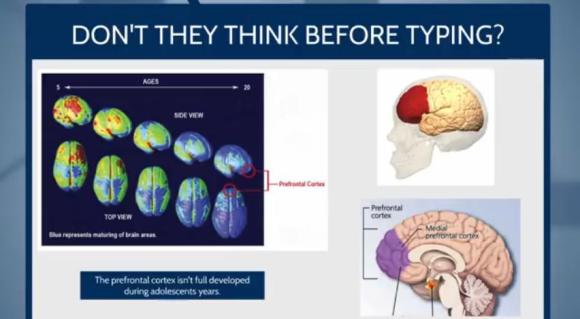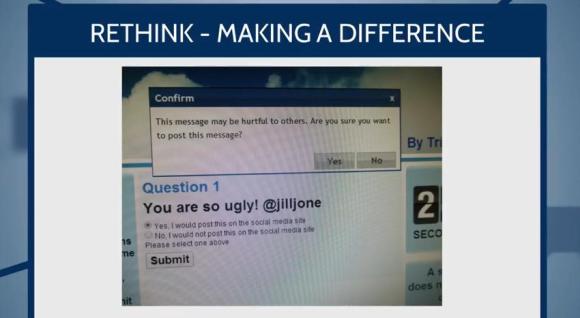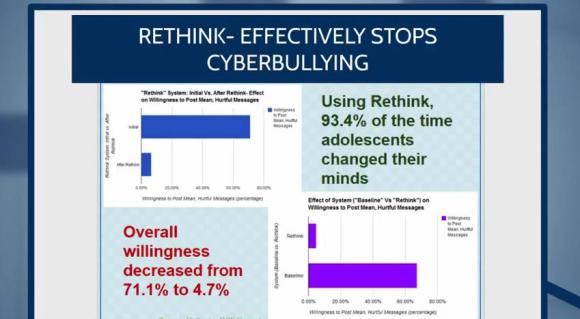
Bullying is not a new phenomenon. Even if you haven’t personally experienced it, you likely know some who has been bullied, or have seen it happen to someone else. So have our parents, and most likely their parents too. Adults can be bullies too, but children and adolescents are much more likely to act without thinking, making it much more of a problem for the younger generation.
What is a relatively new phenomenon, however, is cyber bullying. After hearing about a young girl who was bullied to the point that she decided to commit suicide, 14-year-old Trisha Prabhu knew something had to be done, and set to work making a system that could drastically reduce the incidences of cyber bullying.
With technology and social media now a part of our everyday lives, it’s not much of a surprise that the taunting and teasing of classmates and peers has taken on a new form. Now, not only is it just mean words and occasional fistfights in the school yard, it is hateful and embarrassing words, photos, and videos permanently and publicly displayed for anyone to see. The anonymity that the internet often provides only exacerbates the situation.
When Trisha heard the news of the young girl who took her own life because of the relentless online teasing she endured, the young teen was heartbroken, and decided then to do what she could to prevent something like that from happening again.
It was after learning of a particular fact about adolescent brains that she was able to come up with her brilliant idea. The fact is, as our brains develop, they develop from from back to front, the front part of the brain not being fully developed until around age 25. That front part of our brains is what helps us with decision-making. This is why kids are more likely to act on impulses without considering the consequences. When it’s so easy, second nature even for the youth of today, to type up a text message or comment and hit ‘send’, they may not always think about the effect of their words or their actions.
“What if I gave them a chance to think about what they were doing?” Trisha wondered, as she set out on her mission and created the product Rethink, which creates an alert before a potentially offensive message is posted, asking the poster if they really want to write something that could hurt someone else, giving them the chance to stop and think about what they are doing.
In her trial studies, Trisha found that over 93% of the time, when adolescents received that message, they changed their willingness to post the offensive material.
While still in development, Rethink has already gotten Trisha many awards and praise, and she hopes to soon have it available as a Chrome browser extension and mobile add-on, to help stop cyber bullying worldwide.
Trisha’s idea has even reached across to Japan, where bullying is a particularly big problem, cyber-bullying included (something which is known as ネットいじめ netto ijime, netto being the shortened word for internet, and ijime meaning bully or bullying).
https://twitter.com/kaede_d_andmori/status/560129955334348800▲”It’s just one simple warning, but it’s so important. This is an amazing discovery! But with all the thick-headed parents and stuff around in Japan, adults probably need this too…”
勢いで行く前に一回手を止めて考える。それだけのことなのに、こうやって形にして効果をあげることがすごい / 夢はネットいじめの撲滅。14歳の少女が未成年の9割から侮辱的な投稿を無くした方法とは? http://t.co/CJ96VzHDiO @misterspotlightさんから
— ヲンタロー (@swk650r) January 28, 2015
▲”Stop and think before you recklessly act. Such a simple thing, it’s amazing that it’s had this kind of result.”
https://twitter.com/Yoshiwo_Yoshida/status/560235781990539264▲”This is great. I wonder if Japan will use this for the internet and apps too. We’ve rushed too fast into this net-based society.”
At the Zenkoku Ijime Mondai Kodomo Samitto (directly translated as Nationwide Bullying Problem Children’s Summit) held in Tokyo last Saturday, January 24, Japanese youth were also discussing ways to address and prevent the bullying problem that is so prominent in their country.
Is bullying a problem in your country as well? Do you think Trisha’s Rethink system will be successful? Let us know what you think!
Source: YouTube, NAVER Matome
Images: YouTube




 Tough-as-nails bullied Japanese schoolgirl stays home from school, but not because she was sad
Tough-as-nails bullied Japanese schoolgirl stays home from school, but not because she was sad Japanese Twitter user’s sad memory of when school literally refused to look at bullying problem
Japanese Twitter user’s sad memory of when school literally refused to look at bullying problem When bullying happens in Japan, should parents go to the police? We ask an educator
When bullying happens in Japan, should parents go to the police? We ask an educator Parents of bullied teenage girl who committed suicide commission portrait to “attend” Seijinshiki
Parents of bullied teenage girl who committed suicide commission portrait to “attend” Seijinshiki You can now buy bully insurance for your kids in Japan
You can now buy bully insurance for your kids in Japan McDonald’s new Happy Meals offer up cute and practical Sanrio lifestyle goods
McDonald’s new Happy Meals offer up cute and practical Sanrio lifestyle goods All-you-can-drink Starbucks and amazing views part of Tokyo’s new 170 meter-high sky lounge
All-you-can-drink Starbucks and amazing views part of Tokyo’s new 170 meter-high sky lounge Studio Ghibli glasses cases let anime characters keep an eye on your spectacles
Studio Ghibli glasses cases let anime characters keep an eye on your spectacles Is the new Shinkansen Train Desk ticket worth it?
Is the new Shinkansen Train Desk ticket worth it? Starbucks reopens at Shibuya Scramble Crossing with new look and design concept
Starbucks reopens at Shibuya Scramble Crossing with new look and design concept More foreign tourists than ever before in history visited Japan last month
More foreign tourists than ever before in history visited Japan last month Beautiful Sailor Moon manhole cover coasters being given out for free by Tokyo tourist center
Beautiful Sailor Moon manhole cover coasters being given out for free by Tokyo tourist center Our reporter takes her 71-year-old mother to a visual kei concert for the first time
Our reporter takes her 71-year-old mother to a visual kei concert for the first time Arrest proves a common Japanese saying about apologies and police
Arrest proves a common Japanese saying about apologies and police Mister Donut ready to make hojicha dreams come true in latest collab with Kyoto tea merchant
Mister Donut ready to make hojicha dreams come true in latest collab with Kyoto tea merchant Disney princesses get official manga makeovers for Manga Princess Cafe opening in Tokyo
Disney princesses get official manga makeovers for Manga Princess Cafe opening in Tokyo Beautiful new Final Fantasy T-shirt collection on the way from Uniqlo【Photos】
Beautiful new Final Fantasy T-shirt collection on the way from Uniqlo【Photos】 Foreign English teachers in Japan pick their favorite Japanese-language phrases【Survey】
Foreign English teachers in Japan pick their favorite Japanese-language phrases【Survey】 Japanese convenience store packs a whole bento into an onigiri rice ball
Japanese convenience store packs a whole bento into an onigiri rice ball We try out “Chan Ramen”, an underground type of ramen popular in the ramen community
We try out “Chan Ramen”, an underground type of ramen popular in the ramen community Studio Ghibli releases Kiki’s Delivery Service chocolate cake pouches in Japan
Studio Ghibli releases Kiki’s Delivery Service chocolate cake pouches in Japan Japan’s bone-breaking and record-breaking roller coaster is permanently shutting down
Japan’s bone-breaking and record-breaking roller coaster is permanently shutting down New definition of “Japanese whiskey” goes into effect to prevent fakes from fooling overseas buyers
New definition of “Japanese whiskey” goes into effect to prevent fakes from fooling overseas buyers Our Japanese reporter visits Costco in the U.S., finds super American and very Japanese things
Our Japanese reporter visits Costco in the U.S., finds super American and very Japanese things Studio Ghibli unveils Mother’s Day gift set that captures the love in My Neighbour Totoro
Studio Ghibli unveils Mother’s Day gift set that captures the love in My Neighbour Totoro Foreign passenger shoves conductor on one of the last full runs for Japan’s Thunderbird train
Foreign passenger shoves conductor on one of the last full runs for Japan’s Thunderbird train Domino’s Japan now sells…pizza ears?
Domino’s Japan now sells…pizza ears? New Japanese KitKat flavour stars Sanrio characters, including Hello Kitty
New Japanese KitKat flavour stars Sanrio characters, including Hello Kitty Kyoto creates new for-tourist buses to address overtourism with higher prices, faster rides
Kyoto creates new for-tourist buses to address overtourism with higher prices, faster rides Sales of Japan’s most convenient train ticket/shopping payment cards suspended indefinitely
Sales of Japan’s most convenient train ticket/shopping payment cards suspended indefinitely Sold-out Studio Ghibli desktop humidifiers are back so Totoro can help you through the dry season
Sold-out Studio Ghibli desktop humidifiers are back so Totoro can help you through the dry season Japanese government to make first change to romanization spelling rules since the 1950s
Japanese government to make first change to romanization spelling rules since the 1950s Ghibli founders Toshio Suzuki and Hayao Miyazaki contribute to Japanese whisky Totoro label design
Ghibli founders Toshio Suzuki and Hayao Miyazaki contribute to Japanese whisky Totoro label design Doraemon found buried at sea as scene from 1993 anime becomes real life【Photos】
Doraemon found buried at sea as scene from 1993 anime becomes real life【Photos】 Tokyo’s most famous Starbucks is closed
Tokyo’s most famous Starbucks is closed One Piece characters’ nationalities revealed, but fans have mixed opinions
One Piece characters’ nationalities revealed, but fans have mixed opinions We asked a Uniqlo employee what four things we should buy and their suggestions didn’t disappoint
We asked a Uniqlo employee what four things we should buy and their suggestions didn’t disappoint Princesses, fruits, and blacksmiths: Study reveals the 30 most unusual family names in Japan
Princesses, fruits, and blacksmiths: Study reveals the 30 most unusual family names in Japan “Bully insurance” now on the rise, with many more practical uses than just insuring bullying
“Bully insurance” now on the rise, with many more practical uses than just insuring bullying Court verdict reached on Kyoto schoolgirl who sued bullies for causing her mental illness
Court verdict reached on Kyoto schoolgirl who sued bullies for causing her mental illness Poignant video about inner beauty is an unlikely ad for a beauty clinic 【Video】
Poignant video about inner beauty is an unlikely ad for a beauty clinic 【Video】 Saitama lieutenant calls subordinate’s lunch “garbage”, then loses job for eating garbage lunches
Saitama lieutenant calls subordinate’s lunch “garbage”, then loses job for eating garbage lunches Japanese Twitter tears up over touching tale of why bullied child never contemplated suicide
Japanese Twitter tears up over touching tale of why bullied child never contemplated suicide Curry restaurants across Japan create social media movement: “Don’t blame the curry!”
Curry restaurants across Japan create social media movement: “Don’t blame the curry!” Councilman Super Crazy Kun begins work, but considerably less crazy looking
Councilman Super Crazy Kun begins work, but considerably less crazy looking Why is the iPhone the smartphone of choice for young Japanese women?
Why is the iPhone the smartphone of choice for young Japanese women? Try our crappy lifehack for “better BMs”
Try our crappy lifehack for “better BMs” Email spam exhibition held online by Japanese telecom giant
Email spam exhibition held online by Japanese telecom giant Half-Chinese woman undergoes extensive cosmetic surgery to become the next living Barbie doll
Half-Chinese woman undergoes extensive cosmetic surgery to become the next living Barbie doll 7 more things foreigners do that Japanese people find amusing
7 more things foreigners do that Japanese people find amusing Can’t cope with the feeding frenzy at meal times? Why not stack your cats!
Can’t cope with the feeding frenzy at meal times? Why not stack your cats! If you want your kids to go to elite universities, give them Legos, Japanese study says
If you want your kids to go to elite universities, give them Legos, Japanese study says
Leave a Reply